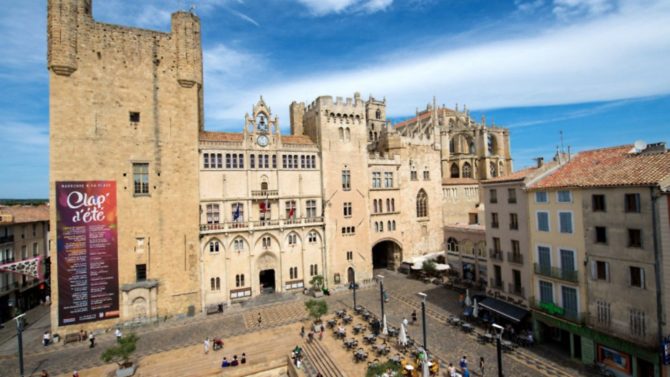Discover the enchanting and historic city of Narbonne

More than just a stopping point, Narbonne is a beautifully diverse city with the marks of centuries of civilisation. Let this Aude town cast its beautiful and medieval spell on you…

Still bearing the stamp of its location at the crossroads of antique civilisations, Narbonne retains its age-old traditions and its unique way of life. The foundation of this was wine which has been a key feature of its development since the very first vine were planted.
It is this primary cultural reference along with other aspects of its heritage that make the Narbonne area so rich.

Narbonne’s flavours
The nearby dry limestone hills, cooled by the sea breeze, are home to the flourishing vineyards of La Clape, Quatourze and Corbières. In fact, vineyards can be seen wherever one looks from the town. This is what gives Narbonne its personality and way of life, the art of matching food and wine is something of a science here!
Lucques olives are only grow in the lands of the Languedoc. They are notable for their elongated shape, like a rugby ball – so appropriate for a region where rugby is a passion! These olives have a firm and tasty flesh and are a perfect addition to your appetizers.You can find Lucques olives in Narbonne at the “Halles” market. This hundred year-old market is a cornucopia of the wonderful wares produced in the area, with a selection of treats for real gourmets: olives, honey, thyme, rosemary, oysters and sardines, not to mention the local IGP and AOC wines. The more inquisitive visitor may go to the vineyards and taste the wines at their source in the company of vignerons passionate about their art.

Historic sites and monuments
In Narbonne, you just have to dig up your garden or do up your cellar to see 2500 years of history. The city was the first Roman colony to be founded outside Italy. Today if you go down the flight of steps under the Place de l’Hôtel de Ville, you can contemplate a section of the Domitian Way, which used to link Italy to Hispania. Witnesses of this glorious past include the Horreum, an immense and remarkably well-preserved underground warehouse, and a multitude of remains and mosaics which will be gathered together in the future museum of Roman civilization called Narbo Via.
The archeology museum is housed in the Archbishops’ palace, guarded by an impressive keep. This astonishing architectural ensemble served in its days as a model for the papal Palace in Avignon. The High Gothic style of the Cathedral of Saint-Just and Saint-Pasteur takes its inspiration from the great cathedrals of Northern France. Its most striking feature is its unique choir, with vaulting soaring to more than 40 metres.

Nature
Encircled by salt lakes, lagoons, aromatic pine woods and lazily growing vineyards, Narbonne is blessed by the gods. Set in the middle of the Narbonnaise Natural Regional Park on the shores of the Mediterranean sea, the environment is exceptionally well preserved. The two summits of Fontfroide and la Clape are classified natural sites and a privileged area for hikers.
The Canal de la Robine stretches from the Junction Canal, which links it to the Canal du Midi, all the way to the sea near the protected island of Sainte Lucie, passing straight through Narbonne on the way. Lovers of calm waters can rent electric boats. Some may prefer the wonderfully tended banks of the canal in the shade of the centenary plane trees, for a delightful walk or bike ride.
A major stopping place for birds migrating and wintering, the area around Narbonne is one of the rare unspoilt natural sites on the shores of the Mediterranean on such a large scale. Between the Corbières massif and the coastal lagoons, it offers 373 kilometres of sign-posted paths to be taken on foot or by mountain bike. Various activities, themed storytelling, traditional days in villages, winemakers’ tours, pastoral circuit, sensorial and creative walks… will allow you to appreciate all the riches of this area that are so precious for its biodiversity and beauty.
More info on the Regional Natural Park : www.parc-naturel-narbonnaise.fr
How to come to the Aude : Daily direct flights from London Stansted to Carcassonne have opened up south-west France, making it a perfect destination for short breaks all year long. Carcassonne is also linked to Nottingham East-Midlands, Manchester, Glasgow and Edinburgh, as well as Dublin and Cork in Ireland.
More info about tourisme in Narbonne : www.narbonne-tourisme.com
For more info visit www.audetourisme.com
Share to: Facebook Twitter LinkedIn Email


